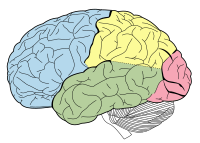
Photo from wikipedia
Primates use their arms in complex ways that frequently require coordination between the two arms. Yet the planning of bimanual movements has not been well-studied. We recorded spikes and local… Click to show full abstract
Primates use their arms in complex ways that frequently require coordination between the two arms. Yet the planning of bimanual movements has not been well-studied. We recorded spikes and local field potentials (LFP) from the parietal reach region (PRR) in both hemispheres simultaneously while monkeys planned and executed unimanual and bimanual reaches. From analyses of interhemispheric LFP-LFP and spike-LFP coherence, we found that task-specific information is shared across hemispheres in a frequency-specific manner. This shared information could arise from common input or from direct communication. The population average unit activity in PRR, representing PRR output, encodes only planned contralateral arm movements while beta-band LFP power, a putative PRR input, reflects the pattern of planned bimanual movement. A parsimonious interpretation of these data is that PRR integrates information about the movement of the left and right limbs, perhaps in service of bimanual coordination.
Journal Title: Nature Communications
Year Published: 2021
Link to full text (if available)
Share on Social Media: Sign Up to like & get
recommendations!